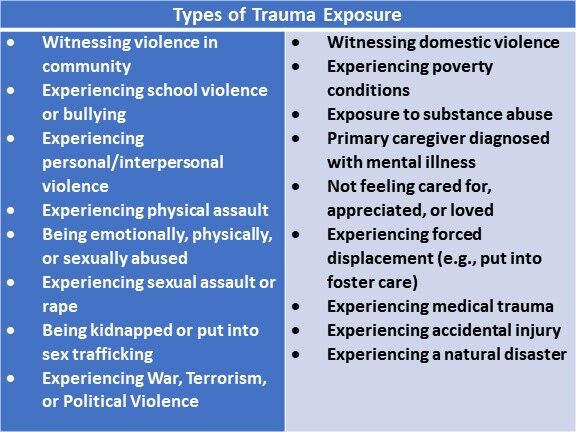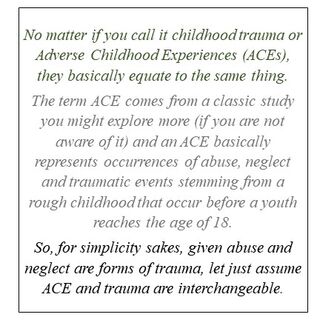Trauma
Sending Out an SOS: Help Combat Childhood Trauma
Kids in CPS, foster care, and poverty need our help.
Posted July 8, 2022 Reviewed by Lybi Ma
Key points
- More than 258 million adults and 48 million youth in the U.S. are victims of childhood trauma.
- Not enough professionals are trained to stem the tide of trauma, and critical mistakes in care are being made.
- Since 1973 more than 50 trauma-informed bills have been introduced, but only two became law with limited funding.
Just a Castaway
Childhood trauma impacts more than 60 percent of adults and 66 percent of children in the U.S., according to the Centers for Disease Control (C.D.C.) and Substance Abuse and Mental Health Services Administration (SAMHSA).
And when it comes to detriments to a child’s development and their future well-being, the impact of childhood trauma is profound. With limited treatment resources and the high cost of trauma-informed care, and most victims’ families do not have the insurance or income to afford it, far too many are feeling more lonely than any man, woman, or child could bear.
In hopes that someone gets my message—that more than 10 million children in the U.S. experience childhood trauma annually and we should not leave them feeling like castaways—I’m sending out an SOS in the form of a Synopsis on trauma-based stats, Oversights, and Solutions.
As a nation, the factors triggering trauma such as crime, community and domestic violence, and drug addiction just keep coming. Our schools and child welfare agencies are overwhelmed due to not being adequately equipped, funded, or staffed to care for and support kids exposed to trauma.
There are not enough providers trained in trauma to fill this critical treatment gap. As a result, most adults in a position to help trauma-exposed children might not even know the basics needed to perform the trauma-informed approach four Rs—realizing, recognizing, responding, and resisting.
It might feel like I’m narrating one of those heart-wrenching commercials that airs late at night on sad issues like animal abuse. But this message is not all doom and gloom, there is hope.
With better federal and state support, the possibility exists to implement more effective and efficient proactive treatment approaches to help these traumatized children and prevent future cases. With better safeguards in place, which our lawmakers could pass legislation today to provide, we can significantly reduce childhood trauma exposure and help many kids discover the love that can mend their life and the childhood they deserve.
The Statistics
I should have known this right from the start.
For some, these trauma stats might come as a surprise. It’s possible that maybe at this point, you are like I was at one time, thinking you were alone when it came to being a victim of childhood trauma.
Maybe you thought such adverse childhood experiences, ACEs, did not happen to others, like those in your friend group, so you kept it quiet and pushed it way back, Freudian-deep into your subconscious for decades. Or maybe you were blessed and lucky enough not to experience such distress and emotional damage as a child, and you thought it only happened to a handful of less fortunate kids.
Either way, if you haven’t heard, this silent killer, or the other silent epidemic as some call it, has sadly been rampant for quite some time, and it is not slowing down.
Here is a summary of additional alarming facts:
- More than 1,000 youth are treated daily in emergency departments for physical assault-related injuries.
- In 2019, 1,840 children died of abuse and neglect in the US.
- As of 2020, children of parents who lived in poverty during pregnancy are nine times more likely to face additional traumatic experiences than kids not in poverty.
- Nearly all children in child welfare have experienced at least one ACE related to trauma, abuse, or neglect.
- More than 75 percent of children in foster care experienced 2.5 more times of abuse, neglect, and trauma than others and are far more likely to experience at least four traumatic events.
- Yet all these numbers are probably low because childhood trauma often is not reported.
- Economists estimate childhood trauma costs the U.S.A. annually a half-trillion dollars.
- Yet a 2015 study found lifetime costs of trauma to the U.S.A. equal to $830,000 per victim and that 2.5 million cases in 2015 cost the U.S.A. $2 trillion.
- As Childhelp.org shares, what we spend annually on reactively trying to manage childhood trauma could fund college education for 70 percent of the children in the U.S.A.
The Types of Trauma
I'm not alone in feeling alone.
Whether you are an adult or youth, with so many experiencing one or more of the nearly 20 types of trauma exposure in this supposed civilized world we live in, I suspect I am far from feeling alone, or that much different than others might have once thought. The odds are better than a 50-50 chance that this post is just as personal to you as it is for me. And for the rest of you folks who have a caring heart and are taking the time to read this, we thank you.
But the fact that so many have experienced trauma should not come as a surprise. The types of experiences used to identify trauma consist of a long list of unfortunate life events in far too many homes and communities.
The table below reflects the categories often shared by respected groups such as the National Child Traumatic Stress Network and the National Child Traumatic Initiative, as well as the categories that currently proposed trauma legislation has recommended (S.2086 - Rise from Trauma Act).

Mistreatment and neglect are two more common types of childhood trauma, and “accidents” are the most often reported types of childhood trauma.
These types of experiences related to trauma are often classified further on three levels, including
- acute (single trauma exposure
- chronic (multiple trauma exposure type or incidents
- complex (multiple trauma exposure leading to long-term effects)
Note that the likelihood of complex trauma increases when a child is not treated for acute and chronic levels and when trauma happens at an earlier age.
As you know or can imagine, these experiences keep so many kids from sleeping through the night or finding the energy to smile during the day. And as Angela Duckworth’s collection of research on grit and resiliency supports, when our young citizens don’t have or develop the character and perseverance to push through such experiences, these types of trauma exposure can have a long-lasting negative impact on youth’s psyche and well-being.
I'm sending out an SOS

I ask you to reflect, imagine if you will if you haven’t already, the effect trauma has on a youth being emotionally and physically abused or watching their mother be beaten and abused regularly.
Think about what it would feel like living with a caretaker suffering from addiction or mental health issues.
As they say, it’s those emotional scars that never fade away. But beyond the stats and types of trauma exposure, you should also know the signs or behaviors of childhood trauma (symptoms if you will) include but are not limited to reoccurring flashbacks or nightmares, avoidance, anxiety, depression, anger, fear, shame, difficulty concentrating, problems with trust, self-destructive or risky behaviors, and withdrawal.
Childhood trauma happens across the socio-economic spectrum from rich to poor. In the U.S., however, 13.5 percent of our families live in poverty, and 38 percent of our children live in low-income family homes. And the reality is that the potential for such trauma is dramatically higher for those in lower-income or poverty-level communities.
Are some of these lower-income homes in nice communities and/or such children have loving and supporting families? Of course. But the sad fact is that lower-income homes more often dwell within communities experiencing higher than average crime rates, substance abuse, and issues such as domestic violence.
Lower-income homes are where the majority of foster kids come from. Thus, when it comes to how to combat and approach reducing the prevalence of childhood trauma to make a measurable difference, we might consider a triage approach and, first and foremost, look more specifically at our less economically blessed populations.
Read Part 2 of this series that addresses childhood trauma and how we can help.
References
Bruskas, D., & Tessin, D. H. (2013). Adverse childhood experiences and psychosocial well-being of women who were in foster care as children. Permanente, 17(3),131-141. DOI: 10.7812/TPP/12-121
Clarkson Freeman, P.A. (2014), Prevalence and Relationship between Adverse Childhood Experiences and Child Behavior among Youth Children. Infant Mental Health, 35: 544-554. https://doi.org/10.1002/imhj.21460
Cohen, J.A. (2010). Practice Parameter for the Assessment and Treatment of Child and Adolescents with Posttraumatic Stress Disorder. Journal of the American Academy of Child & Adolescent Psychiatry, 49(4), 414-430. DOI: https://doi.org/10.1016/j.jaac.2009.12.020
Felitti, V. J., Anda, R. F., Nordenberg, D., Williamson, D. F., Spitz, A. M., Edwards, V., Koss, M. P., & Marks, J. S. (1998). Relationship of Childhood Abuse and Household Dysfunction to Many of the Leading Causes of Death in Adults: The Adverse Childhood Experiences (ACE) Study. American Journal of Preventative Medicine, 14(4), 245-258. DOI: https://doi.org/10.1016/S0749-3797(98)00017-8
Garner, A., & Yogman, M. (2021) COMMITTEE ON PSYCHOSOCIAL ASPECTS OF CHILD AND FAMILY HEALTH, SECTION ON DEVELOPMENTAL AND BEHAVIORAL PEDIATRICS, COUNCIL ON EARLY CHILDHOOD, Preventing Childhood Toxic Stress: Partnering With Families and Communities to Promote Relational Health. American Academy of Pediatrics ,148 (2). https://doi.org/10.1542/peds.2021-052582
Houry, D. "Identifying, Preventing, and Treating Childhood Trauma ." , Center for Disease Control and Prevention, 11 July 2019, www.cdc.gov/washington/testimony/2019/t20190711.htm
NCTSN the National Child Traumatic Stress Network Secondary traumatic stress https://www.nctsn.org/trauma-informed-care/secondary-traumatic-stress#:….
Peterson, C., et al. (2018). The economic burden of child maltreatment in the United States, 2015. Child Abuse & Neglect, 86, DOI: 10.1016/j.chiabu.2018.09.018.
Turney, K. & Wildeman, C. (2017). Adverse childhood experiences among children placed in and adopted from foster care: Evidence from a nationally representative survey. Child Abuse & Neglect, 64, 117-129. https://doi.org/10.1016/j.chiabu.2016.12.009
"Understanding Child Trauma.", Substance Abuse and Mental Health Services Administration (SAMHSA), 22 Apr. 2022, www.samhsa.gov/child-trauma/understanding-child-trauma
Walsh D, McCartney G, Smith M, Armour G. Relationship between childhood socioeconomic position and adverse childhood experiences (ACEs): a systematic review. J Epidemiol Community Health. 2019 Dec;73(12):1087-1093. doi: 10.1136/jech-2019-212738. Epub 2019 Sep 28. PMID: 31563897; PMCID: PMC6872440.




